Do you knit? Would you enjoy owning a brand new collection of knitting stitch patterns that includes a beautiful variety of cable patterns, lace patterns, bobble patterns, colorwork patterns, edging patterns, smocking patterns, three-dimensional patterns and motif patterns? And would you also enjoy having 7 new patterns for knitting unique, unusual and interesting finished projects such as a cardigan, sweater, mittens and arm warmers – each of which was inspired by the stitch instructions in the book?
If all this sounds appealing to you, please allow me to introduce you to my new favorite knitting stitch dictionary as of 6-23-2021. It’s called Keiko Okamoto’s Japanese Knitting Stitches: A Stitch Dictionary With 150 Amazing Patterns. The book lives up to its name; it is a super impressive collection of lovely knitting stitch patterns. I think the book is incredibly inspiring. If you enjoy knitting, customizing your own knitting projects or designing knitting patterns for others to use, I think you’re going to find this book invaluable.
What You Need to Know About This Knitting Stitch Dictionary:
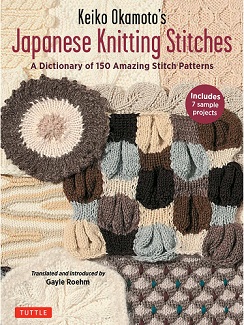
Author: Keiko Okamoto; Gayle Roehm was the translator from the original Japanese into English for this edition of the book.
Publisher: Tuttle Publishing
Copyright Date: I am reviewing the English language translation of the book, which has a copyright date of 2019.
ISBN 13: 978-4805314845
ISBN 10: 4805314842
Book Formats:
This book is available in the following format(s):
Number of Pages: This book has a total of 144 pages.
Skill Level: I didn’t notice any skill level ratings included in the book. In general, I would recommend this book to all knitters, regardless of skill level. If you’re a total beginner to knitting, this book will not teach you the basics of knitting — so you will need at least one other resource to learn your basic stitches and get started. But if you’ve already learned how to knit and purl confidently, there are stitches in this book you’ll be able to do easily.
Having said that, I think intermediate and advanced knitters will get the best value from this book — because many of these stitches and patterns will require you to either have preexisting skills, or to develop the skills as you go. There are some challenging stitches in this book — but don’t worry. This is knitting, not rocket science. If you put your mind to knitting these stitches, you can absolutely do it.
The Focus of This Book:
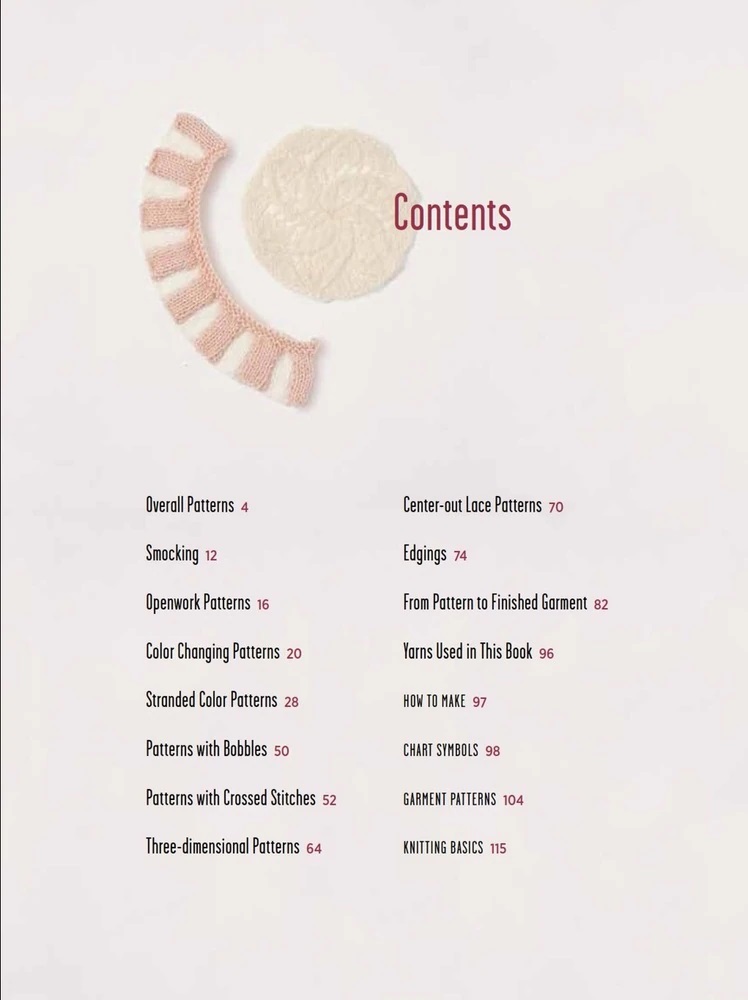
This book is primarily a knitting stitch dictionary, but it’s also partly a pattern book. It includes patterns for making 7 finished projects: 3 sweaters, 1 basket cover, 1 pair of arm warmers, 1 cowl / neck warmer, and 1 pair of mittens.
A small minority of the stitches and projects require some crochet knowledge, as they incorporate crochet stitches. For example, one of the sweaters has a three-dimensional crocheted edging featuring cute strawberry motifs. All the bobble stitches require you to intersperse a little bit of crochet into your knitting, because the bobble stitches are all crocheted. But, if you don’t crochet, don’t worry — the vast majority of the stitches in this book do not require any crochet knowledge.
Knitting Projects Included in This Book:
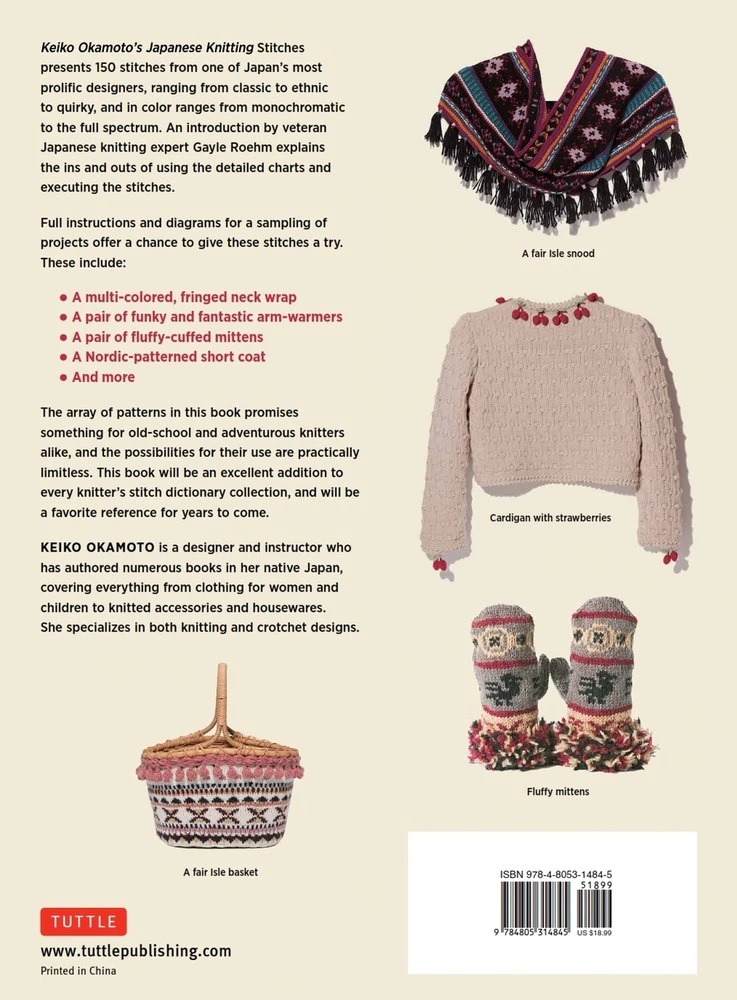
Cardigan With Crochet Strawberry Edging
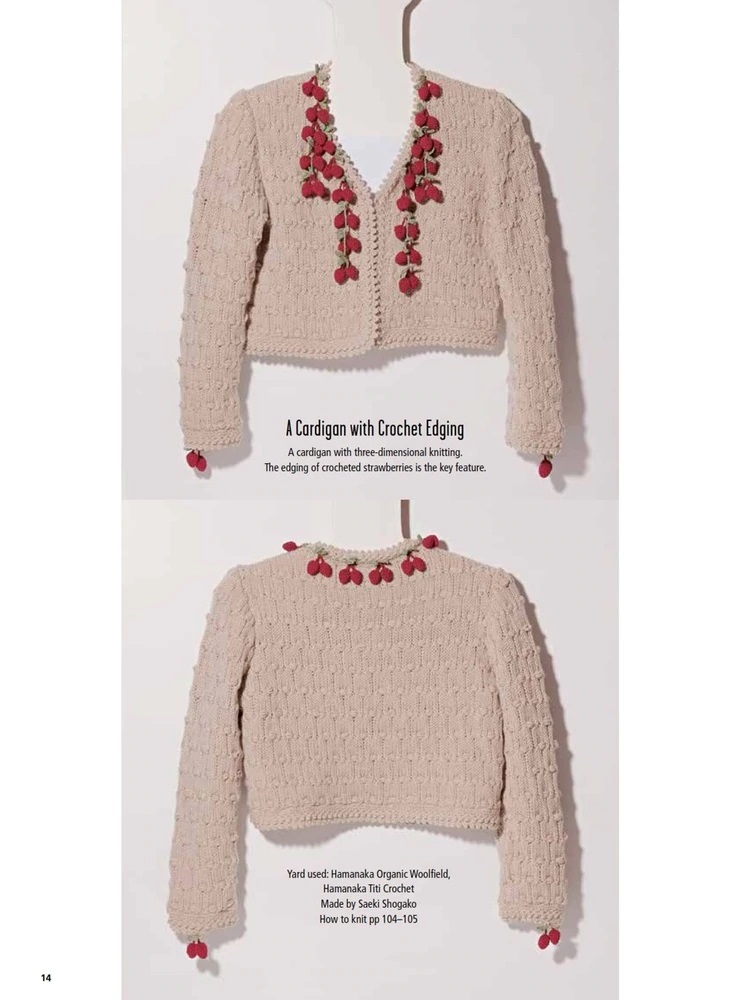
Abstract, Three-Dimensional Arm Warmers
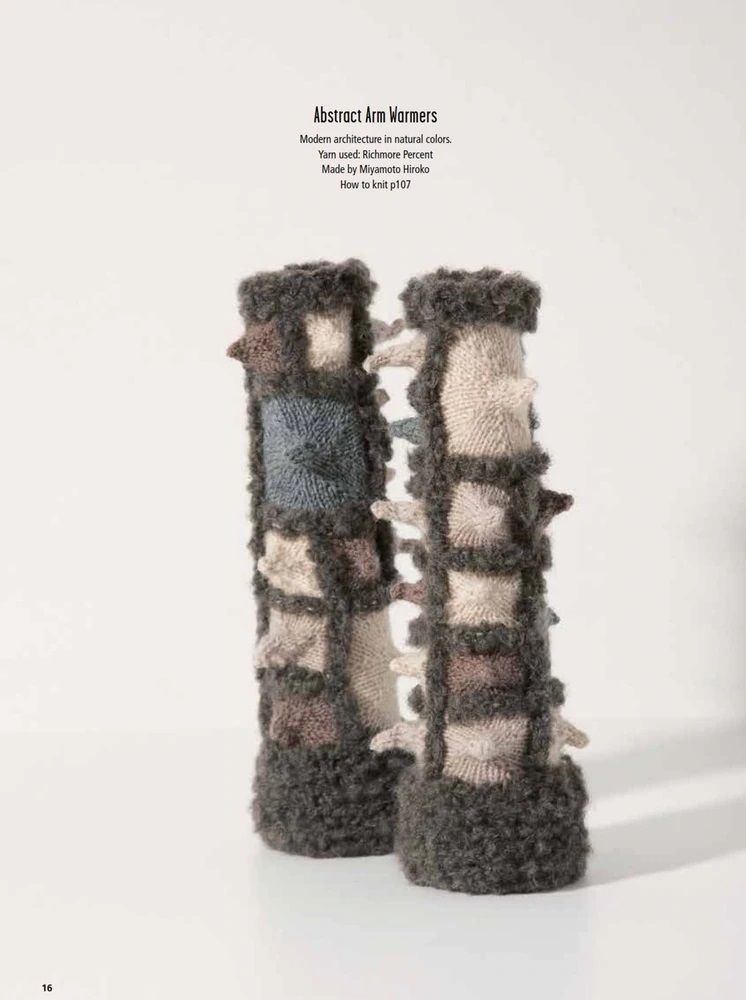
Multicolored Fringed Cowl
This is a versatile wardrobe piece, and there are bunches of different ways you could wear it — as a poncho, snood, cowl or neck warmer. This sophisticated project is made using 2 of the stitch patterns included in the book — one of the colorwork patterns, plus one of the edging patterns.
Fair Isle Basket Cover
This ultra creative project is made using one of the colorwork stitch patterns from the book, plus an extra crochet edging pattern (which is included).
Fringed Mittens
These mittens are knitted using 2 of the colorwork stitch patterns from the book.
White Sweater
This subtly textured sweater features a round neckline, long sleeves and a gentle A-line silhouette that is flattering to a variety of figures.
Nordic Coat
This classic patterned sweater is a head-turning design that is sure to work well into your wardrobe if you choose to knit it.
The Knitting Techniques You’ll Find in This Book:
I made an attempt at counting and classifying the different types of stitches presenting in this book — but that’s a challenging task, as some of them defy easy classification. Please take the following counts as general estimates rather than set-in-stone fact.
I counted…
- 21 patterns featuring cables, crossed stitches and / or twists (plus 1 of the openwork / lace stitches mentioned below also includes twists).
- 44 Colorwork stitches (plus some of the smocking stitches that I didn’t count here also feature multiple colors). 6 of these are floral designs.
- 5 Bobble stitches (the bobbles are crocheted and the rest of the design is knitted).
- 33 Edging patterns — please note that none of these edging patterns include corner instructions. They are all straight across edgings or gently curved edgings.
- 9 lace motif patterns: 2 hexagons, 3 squares and 4 circles
- 10 three-dimensional patterns, some of which feature colorwork
- 12 Lace and openwork patterns
- 9 Smocking stitches (plus 2 of the edgings and one of the lacy openwork stitches also have smocking).
- 10 miscellaneous textured stitches
- 4 simple knit and purl patterns
Knitted Edging Patterns From Keiko Okamoto’s Japanese Knitting Stitches Book
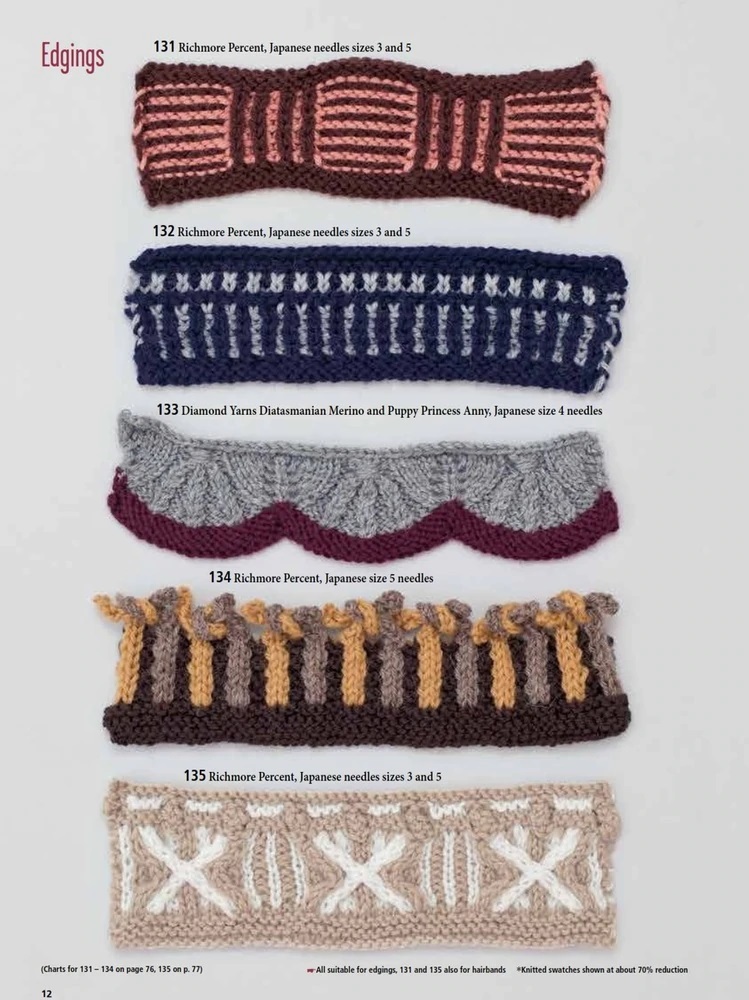

The Best Things About This Book
You’re sure to appreciate the wide variety of different stitches and techniques included in this book.
There are some really creative and unusual ideas included in this book — ideas that you may not already have available in your knitting library. Do you already have any smocking knit stitch instructions among your other knitting references? How about knitting stitches that are made using two different needle sizes?
No?
These are a couple of examples of the unique information you will get access to if you pick up a copy of this book.
My favorite part of the book is found on pages 88-89 in a section called “From Pattern to Finished Garment”. Keiko says,
I’ve used eleven of the stitch patterns in this book to design a variety of finished items. I introduce them here, with my designer’s comments. I hope the hints will help you to make the best use of the patterns.
She then goes on to show you how she has combined some of the stitch patterns and the edging patterns from the book to create the projects.
Most stitch dictionaries give you stitches to use, but they don’t give you much in the way of solid information about how to get from A to Z when designing your own projects. So I think aspiring knit designers will find these examples to be one of the most valuable things about the book. The author doesn’t go into any detail about the thought process behind her designs, which would have been even more helpful to have — but the examples are really helpful, interesting and inspiring nonetheless.
The stitch patterns in this book are varied and lovely. The book gives you examples of stitch patterns that utilize a whole bunch of different knitting techniques.
I think one of the most important selling points is the time this book could potentially save you in your own knit design process. Here you have a solid collection of extremely wearable, useful, stylish yet a bit out-of-the-ordinary patterns to draw from. All you have to do is take them and use them. Working out this many stitches from scratch would take you soooooooooo much time — but Keiko has invested the time so you don’t have to. She has given you the gift of an incredible shortcut.
Right now, in the USA, federal minimum wage is $7.25 USD per hour. At Amazon’s current price for the book, it’s valued at less than what 2 hours of time would cost for the lowest paid workers in the country. Unless you’re an unusually fast designer, it would probably take you more than 2 hours to work out how to do JUST ONE of these knitting stitches. You do the math on how much time it would take you to design 150 knitting stitches of this quality and calibre — and I think you will start to get the idea about why I think this book is an incredible value for its asking price. You get a lot for your money here — 150 highly creative knitting stitches in a huge variety of different techniques, PLUS 7 finished projects, for an extremely attractive price.
Other Observations About This Book
Almost all of the instructions in this book are presented as knitting charts — without extensive accompanying text instructions. I believe this was a smart editorial choice. If written instructions had been included in every case, this would have had to be a multi-set encyclopedia rather than the concise knitting stitch dictionary you have here. But, the downside is, if you prefer working from written instructions rather than charts, you’re out of luck with this book. Any knitter who prefers working from text instructions will probably be happier with a different stitch dictionary than this one. But if you prefer working from charts, I think you’ll be pleased with this book.
I’m a huge fan of Barbara Walker’s, and her legendary stitch dictionaries are the gold standard that I compare all other stitch dictionaries against. Are you wondering how this book stacks up against Barbara’s classic texts? Here’s my honest opinion.
Keiko’s new stitch dictionary is printed in full color, which is a huge selling point for this book over Barbara Walker’s stitch dictionaries — which are printed in black and white. On one hand, Barbara Walker’s books are truly affordable considering what you get for your money; and, the black and white printing is one reason they are such a great value (because black and white printing is considerably cheaper than color printing is). However, knitters who would prefer to work from a full-color pattern book are sure to appreciate the crisp, clear, detailed, colorful photos presented in Keiko’s book. While I adore Barbara Walker’s stitch dictionaries, I do find it more enjoyable and valuable to have the opportunity to work from a book printed in full color. So that is one important reason this book has become my new favorite knitting stitch dictionary.
If you’re interested in color knitting patterns, this book includes multiple outstanding choices that are specifically designed for that purpose. Several of them are pictured on the front cover, but in my opinion, they didn’t even pick the prettiest ones to feature in that prime spot.
This book includes multiple impressive and complex colorwork patterns. In the majority of cases, the colors combinations presented in this book feature just the right level of contrast to be totally effective — which is not an easy thing to achieve. I don’t personally care for all of the color combinations presented in this book, but I acknowledge that they were chosen by a masterful colorist.
Color is a personal thing, and we all have our own opinions about it. You might LOVE the colors in these patterns exactly as is. BUT, if you don’t, please feel free to re-color any of these designs. If you do re-color them, I recommend studying the original colorways, and replicating the same general relationships between colors in your new colorways.
For example, when you look at any of the floral designs presented in this book, you’ll notice that the flower center generally “pops” out from the other colors; in your re-colored floral, you’ll want to maintain that same level of “pop” by using the brightest or most noticeable color as the flower center in your new colorways.
Another important selling point for this book: The finished projects in this book give you some extremely helpful examples of how to take a knitting stitch pattern and transform it into a finished project. As far as I can remember, Barbara Walker’s stitch dictionaries do not have this. So if you’re new to knit design, and you need examples to get you started, that’s another reason why you might want to choose this book over other similar titles like Barbara Walker’s. Once you have a chance to examine these examples, where stitch patterns are transformed into finished projects, you’ll hopefully feel empowered to try using these stitches to customize your own sophisticated designs.
Keiko’s book has fewer stitches than the typical Barbara Walker volume has. At 144 pages, it’s significantly shorter than Barbara Walker’s 400-page Second Treasury of Knitting Patterns published by Schoolhouse Press. However, I think you’ll be delighted by the variety of lovely stitches included in Keiko’s book.
You have lots of amazing choices for knitting stitch dictionaries — and all of them have something valuable to offer you. The truth is, if you are serious about knitting, you’ll want to have more than one knitting stitch dictionary in your library. If your book buying budget permits, I’d say get yourself a copy of this book PLUS some of Barbara Walker’s stitch dictionaries, too. But if you can only justify buying ONE book right now, Keiko Okamoto’s Japanese Knitting Stitches is a fantastic choice to consider.
Things to Be Aware of Before You Buy This Book
The designer used Japanese yarns to create these designs — and some of the yarns she used have now been discontinued. The book includes detailed information about the suggested yarns, including a link to easily locate each yarn online. But even so, if you want to knit any of the finished projects in the book, you’ll probably want to consider making yarn substitutions.
The sweater patterns in this book are each only graded for one size. However, excessively detailed schematics are included — so if you are inclined to do a bit of work to grade the pattern, you should be able to make it in your size, no matter what your size actually is.
I’m reviewing the paperback version of this book — and I would totally recommend it. Both the paper quality and the quality of the binding are excellent.
This book’s page layout requires you to either flip back and forth between pages, or make copies of your frequently used pages to avoid having to flip back and forth. For that reason, I wouldn’t recommend buying the Kindle edition as your only working copy of the book. As far as I know, you won’t be able to print pages from the Kindle version, and you’re likely to find it challenging to flip back and forth between pages.
However, what I WOULD recommend: Buying both a Kindle edition AND a paperback copy to use together, if you are so inclined. You’ll most likely be able to work more efficiently if you are able to use both a digital and physical edition together. But if you don’t have a Kindle, no worries; as I mentioned already, you could achieve similar efficiency by simply photocopying the list of chart symbols and keeping them handy so you don’t have to do so much page flipping.
Conclusion
I have fallen in love with Keiko Okamoto’s Japanese Knitting Stitches — and I think you’re going to love it, too. Knitters of all skill levels, from beginner to advanced, are likely to find this book helpful and valuable. I highly recommend this book to any knitter who is thinking of creating new knit designs, or to anyone who wants to make the specific knitting projects pictured above.
Where to Buy This Book:
More Lovely Knitting and Crochet Books by Tuttle Publishing

- Japanese Knitting Stitch Bible — If you’re interested in knitting the most impressive, the most jaw dropping, the most spectacular knitting projects ever, than this book absolutely NEEDS to be on your bookshelf. It is hands down the most extraordinary stitch dictionary I have ever seen.
- Japanese Knitting — This book features stylish, wearable, unique and lovely knitting and crochet patterns for ladies’ garments and accessories. If you’re in search of a new knitting or crochet project to get started on, this book would be a great place to find some worthy options.
- Japanese Knitting Stitches From Tokyo’s Kazekobo Studio — If you’re a new knitter, or you like working easy yet attractive stitch patterns, you absolutely must see this book. The book features a whole bunch of totally easy, yet GORGEOUS stitch patterns. It also includes some stunning and complex cable patterns that look like they’d be worth the investment of time and brainpower to use in your projects. Overall, I think this book has the potential to become your most-used knitting stitch dictionary ever.
- Voodoo Maggie’s Adorable Amigurumi — If you want to crochet cute amigurumi toys using photo-intensive step-by-step tutorials, you’re in luck. Voodoo Maggie hooks you up with patterns and tutorials you can use for doing exactly that.
Similar Knitting Books and Related Resources

Keiko Okamoto’s Japanese Knitting Stitches book is an excellent “generalist” knitting stitch dictionary that covers lots of different knitting techniques, but doesn’t go into a huge amount of depth about any of them. IF you would prefer to study one particular knitting technique in more detail, there are a couple of other stitch dictionaries you might like to know about:
The Big 3 Knitting Techniques Book — Knit sweaters, mittens, hats and more — plus get a lovely library of compelling stitch patterns drawn from 3 different popular knitting techniques. I LOVE this charming little stitch dictionary and pattern book, and it is definitely worth your consideration if you are interested in designing your own knitting projects and patterns.
The Alterknit Stitch Dictionary empowers you to delve even more deeply into studying the technique of stranded colorwork knitting.
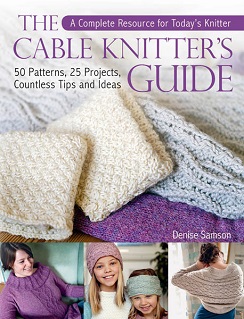
The Cable Knitter’s Guide is a combined stitch dictionary and pattern book that’s exclusively dedicated to helping you improve your cable knitting skills. If you want to explore the technique of cable knitting in depth, that’s a fantastic book to consider adding to your library.
Either of these books would make a fantastic companion for using along with Keiko Okamoto’s Japanese Knitting Stitches. Both of these books include helpful technical information that Keiko’s book lacks — so if you need more information about how to actually knit stranded colorwork or cables, I think you’ll find these suggestions helpful.
Do you crochet? If so, I also invite you to check out our list of the best crochet stitch dictionaries.
Knitting Tools and Supplies
Posted By: Amy Solovay
About Your Book Reviewer: Amy Solovay learned to crochet as a child and to knit as a teenager. She later earned a degree in textile design and pursued a career in textile manufacturing. She has also worked as an instructor, teaching textile design and trend forecasting to fashion design majors at the college level. She invites you to make use of the many resources offered here at KnittingCrochetCrafts.com including craft tutorials, craft patterns, craft project ideas and craft book reviews.
This page was last updated on 8-5-2023.